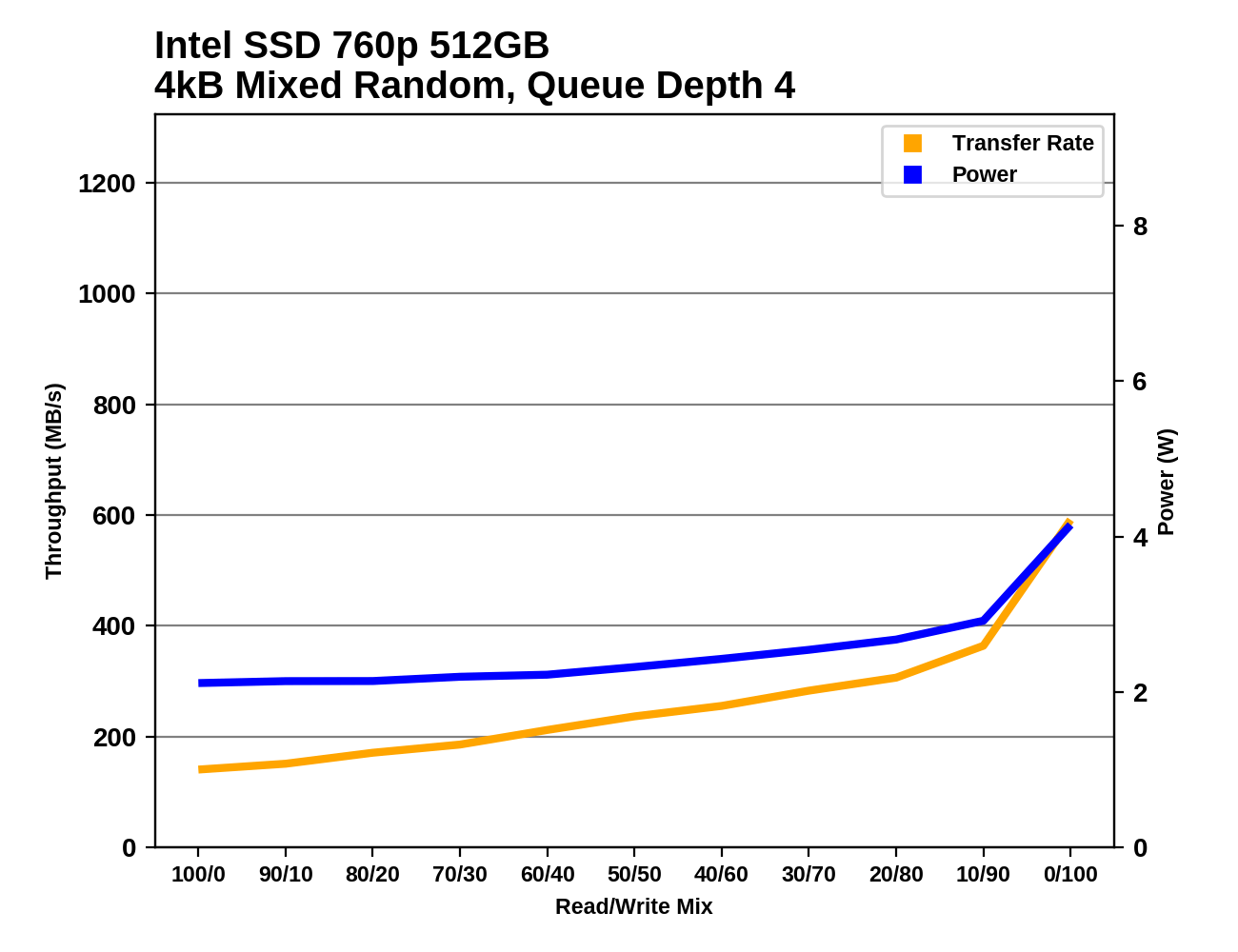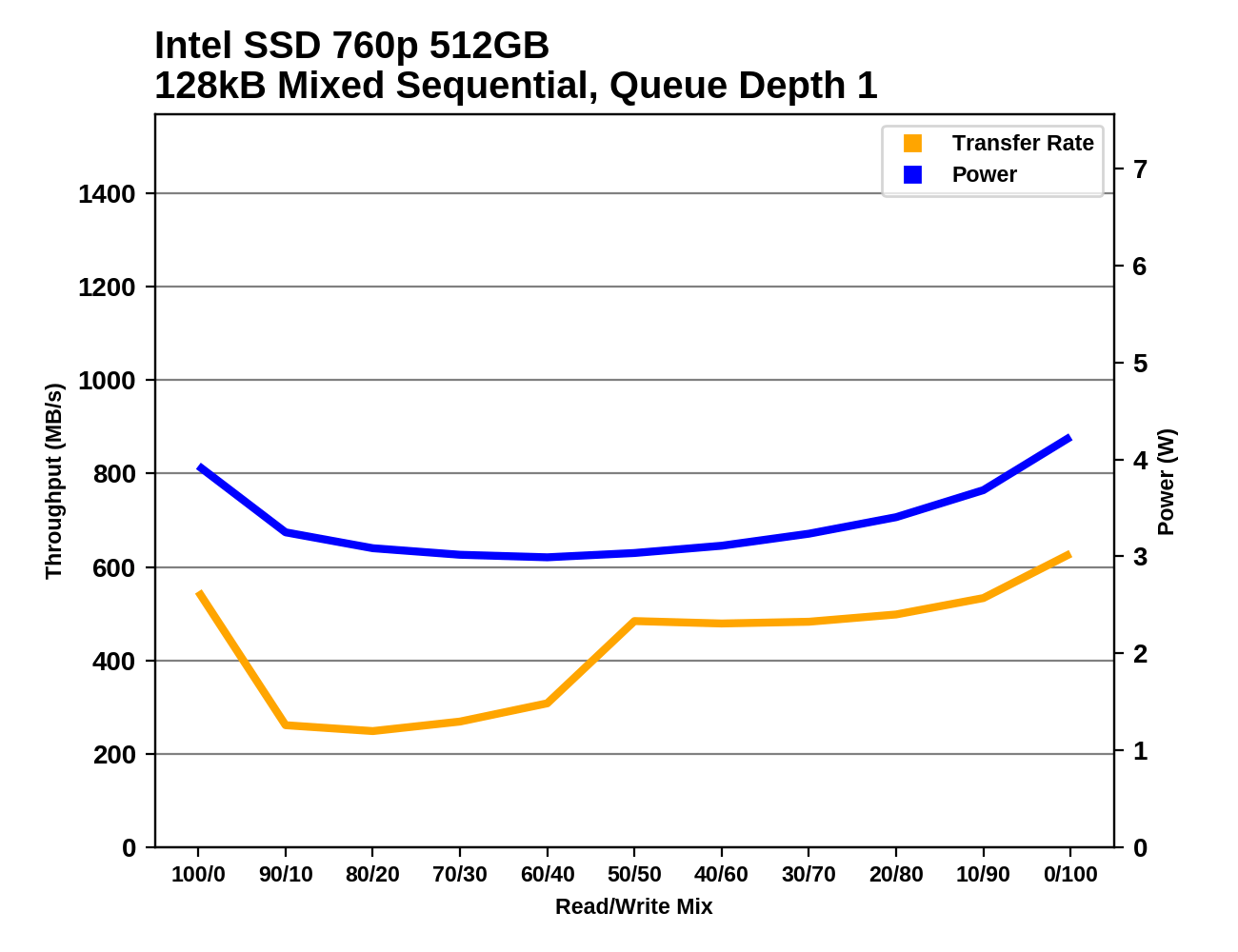The Intel SSD 760p 512GB Review: Mainstream NVMe Done Right
by Billy Tallis on January 23, 2018 11:30 AM ESTMixed Random Performance
Our test of mixed random reads and writes covers mixes varying from pure reads to pure writes at 10% increments. Each mix is tested for up to 1 minute or 32GB of data transferred. The test is conducted with a queue depth of 4, and is limited to a 64GB span of the drive. In between each mix, the drive is given idle time of up to one minute so that the overall duty cycle is 50%.

The overall performance of the Intel SSD 760p on the mixed random I/O performance is quite high for a TLC-based drive. Samsung's PM981 is much better, but the 512GB 760p is almost as fast as the 1TB Samsung 960 EVO. The 760p is clearly a viable competitor to the non-Samsung drives that use MLC NAND flash.

The Intel SSD 760p does not score quite as well for power efficiency as it does for raw performance on the mixed random I/O test, but it is still above average and far better than previous Intel SSDs.
 |
|||||||||
The random I/O performance of the Intel SDD 760p increases gradually but steadily as the proportion of writes increases. It's a good sign that there are no dips in performance along the way, but the performance on the final phase of the test with a pure random write workload is not competitive with the high-end SSDs.
Mixed Sequential Performance
Our test of mixed sequential reads and writes differs from the mixed random I/O test by performing 128kB sequential accesses rather than 4kB accesses at random locations, and the sequential test is conducted at queue depth 1. The range of mixes tested is the same, and the timing and limits on data transfers are also the same as above.

The average performance of the Intel SSD 760p on the mixed sequential workload test does not exceed the limits of a SATA link, but it does clearly beat the best speed achieved by a SATA drive on this test. Previous budget NVMe SSDs have failed to even match the fastest SATA SSDs due to the use of slow TLC NAND.

The power efficiency of the Intel SSD 760p on the mixed sequential I/O test is not great. It only beats drives that were notably slow (600p, WD Black) or unusually power-hungry (Intel 750, Plextor M8PeY). Samsung and Toshiba have set a much higher standard.
 |
|||||||||
The Intel SSD 760p performs much worse during the first half of this test, when the workloads are more read-heavy. By contrast, Samsung's NVMe SSDs tend to be at their worst during the second half of the test. The Samsung drives are much faster at either end of the test when the workload is either pure reads or pure writes, and this helps the Samsung drives secure a clear lead in performance.










51 Comments
View All Comments
HStewart - Tuesday, January 23, 2018 - link
Make sense especially with their own fab, they no longer need Micron to supply, but these chips are older generation, so they probably realize that future generations are not necessaryilt24 - Tuesday, January 23, 2018 - link
Intel converted a factory in China from making chipsets to making 3D-NAND a couple of years ago, then a couple of weeks ago Intel and Micron announced they would stop working together on 3DNAND once their 3rd generation was released ~2019. They said they would continue to collaborate on their 3DXpoint memory.Currently it isn't clear if all of Intel's supply comes from the Intel factory or if they are still getting any from the Micron fabs. Independent of where the flash comes from, it will have the Intel logo since they just get wafers from Micron and package it themselves.
rawcode - Tuesday, January 23, 2018 - link
Your pricing for the the Samsung 960 PRO are way off. You have prices for the 512GB in the 256GB column. 1TB for the 512GB, and 2Tb for the 1TB.Billy Tallis - Tuesday, January 23, 2018 - link
Fixed. Thanks!lux44 - Tuesday, January 23, 2018 - link
I guess post-Meltdown/Spectre benchmarking is in the pipeline, as IO-benchmarks should show a large drop... It definitely will make Core8 benchmarks a lot more interesting. I wish you all good luck in getting to the bottom of the things regarding performance impact, we count on you!tuxRoller - Tuesday, January 23, 2018 - link
Not as bad as was once thought.https://www.phoronix.com/scan.php?page=article&...
Ignoring the XFS results (just that they are using cfq means the fs is starting the fight with one arm, and most of a leg, disabled) it looks like 5% or less (except for the compile benchmark which caused one fs to drop 15%)
lux44 - Wednesday, January 24, 2018 - link
Given recent news about Intel microcode update recall and Linus's rants about unacceptable kernel updates, I think the actual Spectre mitigation impact is unknown, at least under Linux. I doubt it's larger than 15%, but we'll see.Jhlot - Tuesday, January 23, 2018 - link
Bummer, still significantly outpaced by the 960 EVO which was released more than a year ago.msabercr - Tuesday, January 23, 2018 - link
Dang it, this VW Beetle is nowhere near as fast as my 911 turbo.shabby - Tuesday, January 23, 2018 - link
Price is close enough that it should be.